Menu
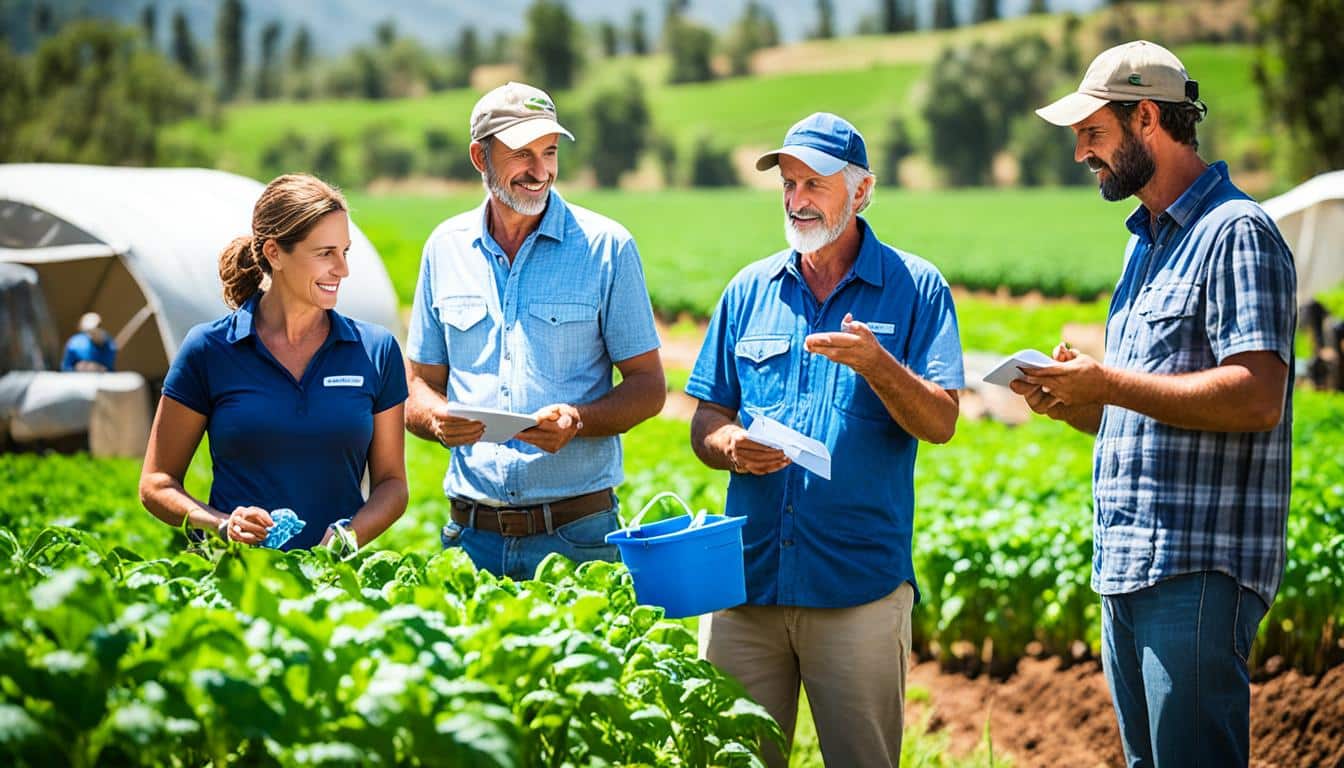
Did you know about the Sulphur Springs Water Alliance in Cochise County, Arizona? It started after a workshop in September 2023. This workshop, the Sulphur Springs Valley XSP, showed how a community can tackle tough water issues together.
This workshop had people from different areas, like farmers, homesteaders, and local leaders. They all aimed to better use and save the area’s water. Surprisingly, out of this came a group focused on smart water use.
A mix of locals played a big part in planning this event. They showed how working together locally helps everyone. This local knowledge made the workshop a success. By working together, they showed that joining forces can lead to better ways of managing water for farming.
Collaborative water management in agriculture is key to saving our water supplies. Only 3% of Earth’s water is fresh, and just 1.2% is drinkable. This highlights the urgency for sustainable farming. With 40% of people facing water scarcity and over 2 billion lacking safe water, we need to change how we use water in farming.
Bad water quality can introduce toxins into our water. Old ways of managing water don’t address these issues well. We need a united effort to deal with pollution. Managing water together in agriculture saves water for everyone and helps avoid high water costs.
Involving the community in agricultural water management is crucial. When everyone works together, it attracts investors, focuses on consumer needs, and can improve laws. Just like the team managing water in parts of the US, successful water management brings experts together. They handle everything from drainage to water quality.
Water management impacts both local areas and the whole planet. In places like the Rapel River Basin, joint efforts have cut down on water wastage. As the climate changes, so do our water needs. Team efforts are vital to make sure everyone has fair access to water. Reports from the World Health Organization and UNICEF show we need to share water more fairly. Working together, especially in farming, helps keep water use sustainable for all.
In managing water, involvement from local communities is key. Their direct input ensures strategies are made to fit each area’s unique needs. This hands-on approach makes the outcomes better and more lasting.
Getting locals to help with water and farm work shares the load. From 2021 to 2022, 11 local groups in Pennsylvania met about these issues. They discussed problems and found ways to help.
Webinars also played a big part. About 184 people joined, sharing their insights on water issues. This helped everyone learn new ways to manage water better. Then, 104 people took part in online talks about working together and using different types of knowledge.
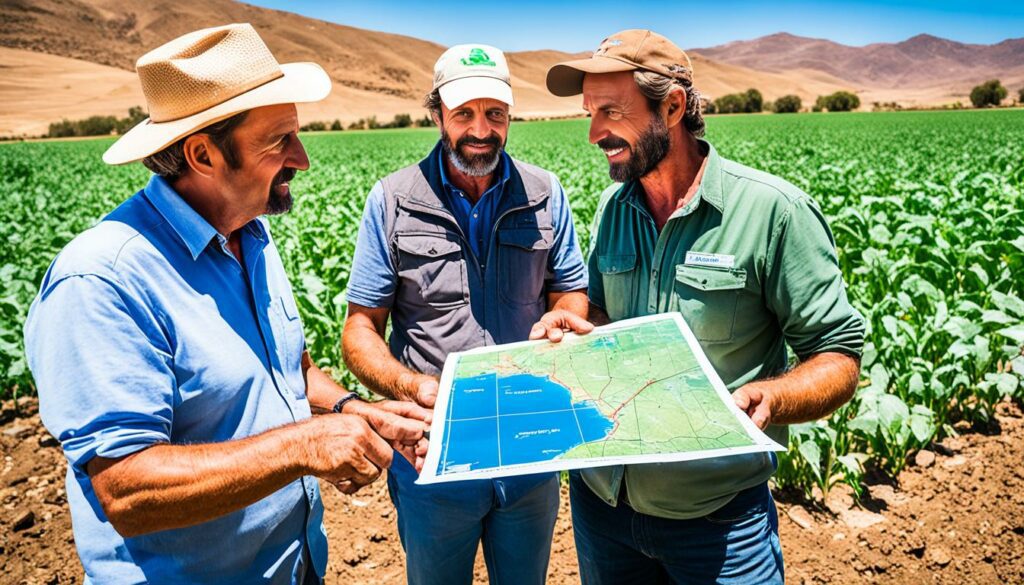
Building trust in water work is very important. It includes talking with people at all five water projects. By holding 11 local meetings and 15 with the public, everyone sees and feels their ideas being used. This builds trust.
The group in North Platte worked with StreamNet to check water in their rivers. This led to more trust because people could see what was being done. Funding from USGS let them test water quality. This showed that using the best methods is important for science to be trusted.
Community work, like that of ADI and WaterAid, shows how much local help can do. Their plans solve water problems now and help greatly in the future. They focus on trust and good science to manage water well over time.
Sustainable farming is key to water resource management in agriculture. It involves using water wisely and cutting down on waste. These steps are vital for the future of farming, which faces the need to produce more food. By 2030, we need almost 50% more food, and by 2050, we need to double our output.
Data from an OECD survey shows how important sustainable methods are worldwide. It’s interesting to see how farmers are saving water and using it better.
Using water well helps save it. Methods like drip and smart irrigation give crops just the right amount of water. This saves water, helps plants grow better, and doesn’t waste a drop.
Planting different crops in rotation is also smart. It keeps the soil in good shape and makes the most of every drop of water.
We must avoid wasting water. Storing water, catching rain, and planting tough crops can all help. The OECD’s report suggests rules to deal with floods and droughts can support these efforts.
| Method | Efficiency | Application |
|---|---|---|
| Drip Irrigation | High | Precise water delivery to roots |
| Rotational Cropping | Moderate | Alternates crops to optimise soil health |
| Rainwater Harvesting | High | Collects and utilises rainwater |
Good water management can help farming tackle big challenges. It helps with growing cities, more industry, and changing weather. Learning from places like Australia can show us more ways to be sustainable. By using water wisely, farmers around the world can help save a lot of water.
Using strategic water management is key in making the most of water in farming. It looks at the whole picture, balancing the needs of people and the environment. This way, we help farming communities thrive while keeping our planet healthy for the future.
Freshwater is a rare resource, making up only 3% of the world’s water. And, just over 1% is safely drinkable. With 40% of people facing water shortages, we must manage our water wisely. Over 2 billion people are without clean water and hygiene, showing how serious this issue is.
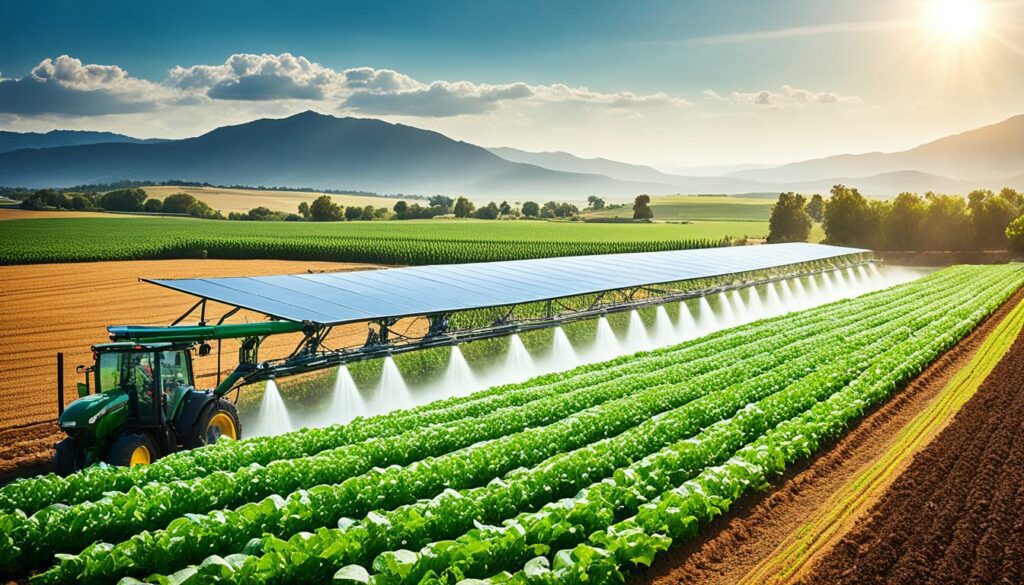
Water is shared between areas rich and poor in water, showing sharing is caring. For example, northern California helps meet the water needs of the south. It’s a perfect example of why we need to work together.
When water is run by private companies, it can end up costing more and being lower quality. This is why many believe managing water should be a public effort. Bad water management can harm our health by polluting our water with harmful substances.
To tackle water shortages worsened by climate change, we must work together. It’s about all stakeholders coming to the table to keep water sustainable and available to everyone. Places like California are leading the way, investing billions in projects that protect water sources and benefits everyone.
California’s move demonstrates the power of planning our water use smartly. We’ve seen huge success in managing water by involving the whole community. Having 48 groups manage water regionally has been a win for the state. And over nearly every Californian has seen the benefits of planning water use well.
Using a whole-systems approach to water and farm management is crucial. It helps improve how we use water, making farming more productive while protecting our land and water. This way, we can ensure our water lasts and our lifestyle is sustainable in the long run.
To sum up, smart water planning and working together are vital in farming. They offer solutions to the challenges we face in using water in agriculture. With a joint effort and forward thinking, we can make sure the future is bright and full of water.
Agricultural water conservation is vital across the globe. It’s the biggest water user, consuming over 50% of all fresh water. Technology, especially in irrigation and data analysis, is now crucial.
Irrigations like drip and sprinkler types have transformed how farms use water. They distribute water evenly, cutting down waste. Fields using such systems can produce twice as much as those left to rain alone.
Rainwater collection is a smart way to lower water use from outside sources. By using rain that’s free and available, farms can diminish their dependence. Using crops that can thrive on less water, along with changing what’s planted seasonally, also helps.
Technology is key in making smarter choices to save water. Tools like EOSDA let farmers check on their crops from a distance. This means they can monitor plant health to better control their water use.
Checking the moisture in the soil is essential for giving plants the perfect amount of water. GPS and other high-tech tools help apply water and nutrients more wisely. This can boost crop production by a quarter. AI is also stepping in. It’s learning to manage water more efficiently without harming yield.
To conclude, saving water in agriculture is no small feat. It takes smart technology and precise watering systems. With new tools and strategies, farms are becoming more efficient and eco-friendly.
The Sulphur Springs Valley Initiative is a big effort in managing groundwater. It focuses on working together for farming needs. This area is special, including the Willcox and Douglas Basins, spread over a large space in Cochise County, Arizona.
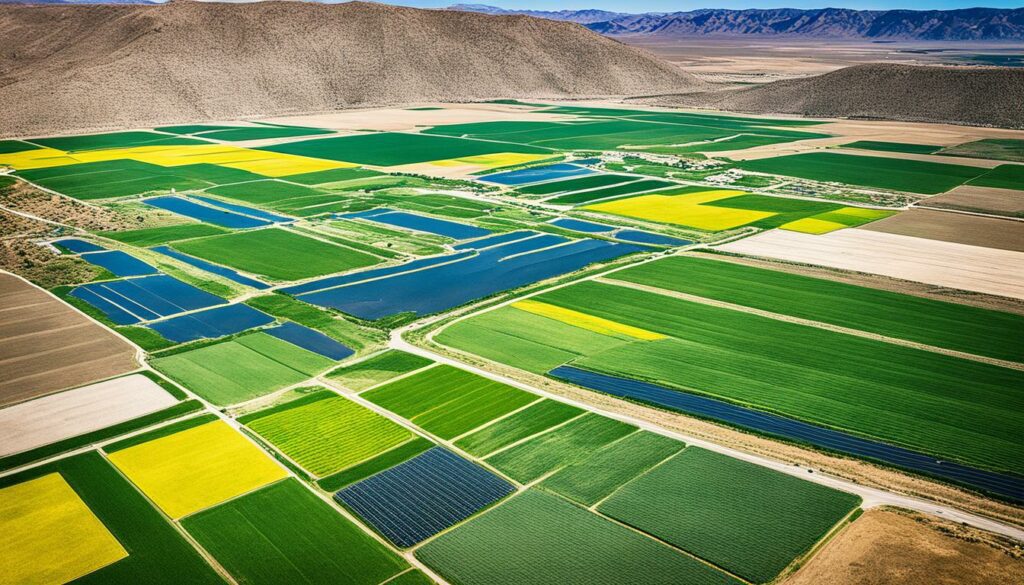
Riverview LLP has been busy since 2015. They have dug 80 wells in the Willcox Basin. Moreover, they’ve dug six more in the Douglas Basin. Most wells are deeper than 1,000 feet. Yet, locals are worried about using too much groundwater.
Special areas called Active Management Areas (AMAs) watch over water use properly. They’re just 13% of Arizona’s land. But they handle 80% of the people and 70% of the water use. In Sulphur Springs Valley, getting an AMA status is crucial for the Arizona Water Defenders. They need support from 10% of the basin’s voters to get it on the ballot.
This story tells us about different groups working together to manage water better. They organise workshops to come up with smart solutions for the area’s water problems.
Some people, like farmer Claire Owen, doubt the new AMAs will help enough. She says the water level has dropped a lot since 1981, making the new plans less useful. Nathan Watkins from San Ysidro Farms wonders if AMAs can really stop big farming from using too much groundwater.
Despite this, the Arizona Water Defenders stay strong in their aim to limit how much water gets pumped. They want to make sure there’s enough water for everyone in the long run. If an AMA is approved this November, the Arizona water officials will work quick. They have 30 days to set the area’s goals and two years to make detailed plans based on advice from different committees.
It’s vital to boost how we use water in farming. This sector uses more than half the world’s fresh water. To make water use better, we use various strategies and tech. These help farm sustainably.
Precision farming is a smart method. It combines tech with expert knowledge. For example, EOSDA Crop Monitoring uses satellite images. These track crop health from afar and give weather info. Farmers can then water crops better, saving water.
Rainwater harvesting is another key technique. It’s been a big help in dry places like Australia. Here, tanks catch rain to water crops and animals when it’s dry. Using native plants and changing crops, it’s possible to use less water. This also helps plants survive during droughts.
Good irrigation systems are important too. They can make fields produce more than relying on rain alone. But, the smart use of technology and soil moisture checks can cut down water use. This way, water is only given to crops when they really need it.
Even treating wastewater for irrigation can help. It means we don’t always need to use up fresh water. And, it lowers pollution too. This method is both good for the planet and helps farming stay sustainable.
Helping everyone improve is key in managing water better. By measuring how much water is used for each crop, we can do better. This helps farmers find where they’re wasting water. They can then use it smarter, growing more and earning more.
| Strategy | Impact |
|---|---|
| Precision Agriculture | Optimises water use with satellite imaging and weather forecasting |
| Rainwater Harvesting | Sustains crops and livestock during droughts |
| Smart Irrigation Systems | Minimises water wastage through targeted application |
| Wastewater Treatment | Reduces reliance on freshwater and pollution |
| Drought-Tolerant Crop Varieties | Enhances resilience and decreases water use |
With agriculture growing, these methods will be more and more important. By managing water well and using smart tech, we can meet future challenges. This way, farming can be sustainable even as water gets scarcer.
The farming sector’s water needs bring many hurdles, underlining the need for greater income and the protection of nature. Old approaches focus heavily on technology and building more. Yet, without working together, those using the water cause a lot of issues and waste.

Managing farm water well needs everyone to get involved. Water stewardship sets up a way for us to manage the land and water better. It makes sure water gets used fairly and taken care of for the future. Working together on water is a top priority in this plan.
When different groups join up, water plans run smoother. Companies, nature groups, and local people all care about water issues. By joining forces, we can use water in a way that’s good for everyone. For example, partnerships in farming water moves the focus to teamwork on local levels, encouraging everyone to do their part.
Working together by talking and sharing power makes for better water use. This helps smooth out the rough patches between all involved.
One way this happens is by letting the people who use the water help decide how to look after it. This is seen in groups that look after water for farming. They get involved in running water systems which helps keep things in good shape. For this to work well, these groups need help from the government and benefits for their hard work.
In Nebraska, USA, places like the North Platte and Central Platte River Valleys show us how forming water partnerships can work. A study looked at 25 different groups working together from 2019 to 2021. The results showed that when people work together across borders, they can manage water much better.
Sharing in making decisions can lead to using water better and setting up the right ways to use less water. This doesn’t just help those involved but also keeps water in good shape for years to come through working together.
In the sprawling Rapel River Basin (RRB), spanning 13,766 km², community water governance is key. This area sees notable precipitation between 450 and 1050 mm/year. It benefits from high river flows of 89.0 and 50.2 m³/s from the Cachapoal and Tinguiririca rivers. These flows make it ideal for collaborative water management. The basin has a large regulation capacity of 932 Mm³, managed by significant reservoirs. This highlights the need for everyone to work together in managing water resources.
Due to a significant drop in rain and river flows over the years, group water management is crucial. These changes need an adaptive response, given the forecasts. Predictions point to temperature hikes and decreased rainfall. By working together, people can tackle these challenges and ensure a fair share of water. The agricultural sector, major water consumer in the RRB, must especially promote joint water use schemes.
To understand how participatory water governance works, we must look at its components. In many places worldwide, the active involvement of both local leaders and community members ensures community needs are at the heart of decisions. It boosts trust. Projects that start from the community or are supported externally aim to get more people involved in making decisions. Even when there are some challenges, the goal is to keep pushing for cooperation. This way, water resources remain sustainable.
Adopting lessons from water management in places like India and Turkey highlights community involvement as crucial. From small to big scales, these studies show the need to address issues like unequal power and social divisions. The process of giving more power should not only favour a few but aim for broad participation. It’s about working together. Both government and non-government groups play a role in making water governance holistic.
So, models that put the community at the centre, where decisions are clear and everyone works together, are critical. They help sustain water, deal with current problems, and prepare for the future.
| Parameter | Value |
|---|---|
| Total Area of RRB | 13,766 km² |
| Average Annual Precipitation | 450-1050 mm/year |
| Average River Discharges (Cachapoal, Tinguiririca) | 89.0 and 50.2 m³/s |
| Regulation Capacity | 932 Mm³ |
| Water Consumption | 45 m³/s (93% agriculture/agroindustry) |
| Reduction in Precipitation and River Flows | 45%, 51% |
Working together to manage water in farming has big challenges. It also offers great chances to improve. By overcoming these challenges and using the chances, we can do better with water in agriculture.
Change is tough because people like to stick with what they’ve always done. Farmers and communities find it hard to start new ways. But in Thailand, the use of geographic information systems (GIS) in Water User Organizations (WUOs) has helped. It got more people involved and taught them better ways to manage water. A study shows GIS made sharing water fairer and solved arguments. This shows how GIS can help us get over these problems.
Joining forces with new technologies and partners opens doors. For example, using geo-informatics helps a lot. It gets more people involved and schedules water use better. Mixing these new tools with the community’s input leads to lasting ways of managing water. Also, the UoF programme teaches water suppliers to be better. They learn to be reliable, open to everyone, and meet high service standards, according to the Water Utility Service Quality Index (WUSQI).
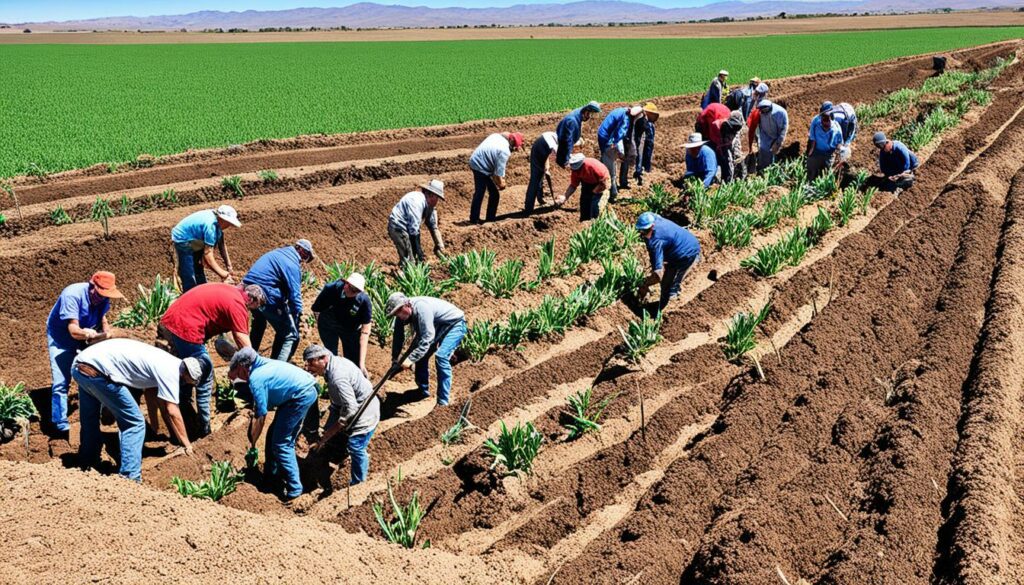
Making everyone work together better is key. This helps everyone understand and work harder towards using water wisely. Sharing water management across groups not only solves today’s issues. It also prepares us for better ways to use water in the future.
The success of working together on water problems shines through many stories. For example, farmers and water companies collaborating on precision irrigation have seen great results. They’ve used less water and still grown as many crops. This shows joint efforts can really make a difference.
Collaboration isn’t just in farming; it’s everywhere. For instance, environmental groups and manufacturers have started eco-friendly processes. These save water and cut waste. Also, energy businesses, by working closely with local areas, have lessened their water use. This has also helped the communities they’re in.
Take the story of the Albert Water Management Zone (AWMZ), a huge area that’s over 1.4 times the size of the Netherlands. It involves many groups, from the government to private companies. At first, these groups didn’t work together much.
But a key turning point was the Watershed Empowering Citizens program in Uganda. It helped start up projects like better use of soil and shifting from quarrying to farming. This united everyone in better ways of using water.
For real change, governments and people need to team up. The AWMZ story is a great example of how this can really work. It’s proof that together, we can use water better. And this helps our planet and the people who live here.
Looking ahead, emerging trends in water management will be key for sustainable agriculture. AI in water management is a big step forward. It can cut water use by 20 to 60%, helping farmers save more.
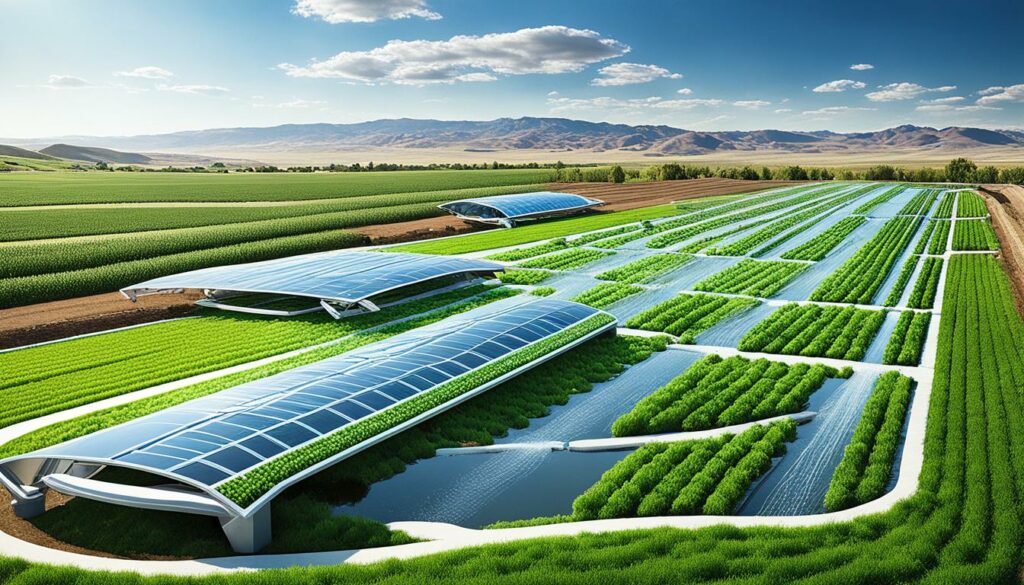
The future of agriculture water use looks bright. Smart systems with AI help stop over-watering. For instance, irrigation systems from the MIT GEAR Lab save over 40% water. These advances make every water drop count.
We face a big challenge with fresh water soon becoming scarcer than the demand. This highlights the need for new solutions like AI. It can make better use of rainwater and recycled water, especially in areas with low water.
About 80% of farms worldwide are small and in places often lacking water. AI helps these farmers plan their water better. The GEAR Lab found success by working directly with farmers in countries like Kenya, boosting water management.
Climate change affects water access, making farming harder. It’s vital to update methods to save water and protect soil. AI helps use fertilisers and water more wisely, reducing harm to the environment.
| AI Implementation Impact | Smallholdings in Water-Stressed Regions |
|---|---|
| Reduces Water Consumption by 40% | 80% of World’s Farms |
| Optimises Water Use | Enhanced Water Management |
| Ensures Technology Adoption | Field Tests in Kenya, Morocco, Jordan |
In agricultural water use, AI is transforming how we use data on weather and water. It helps make farming smart and sustainable. Plus, it’s advancing alongside other farming technologies.
Further AI progress, like using weather and water forecasts, will help farmers better plan. Cooperation between scientists, farmers, and policymakers is crucial. It paves the way for using these tech solutions wisely, securing our water future.
Following water management regulations is key to keeping our farming legal and our water safe. It’s important because it helps us use water-saving tech and methods. This keeps our water safe and helps the environment in the long run.
Working together in water care cuts down on pollution and protects water life. Also, it helps spot and deal with water problems early. This teamwork makes sure everyone follows the rules, avoiding legal trouble and fines.
Joining with the community is crucial. It helps everyone understand and support using water wisely. For example, farms and water firms use new ways to water their crops better. Factories and green groups use less harmful methods. And, power companies work with people to care for water together.
This joint work also brings new jobs and better living for the community. Think about the Northeastern U.S. Farms there have made big impacts on farming and water use, as shown below:
| State | % Dairy Production | % Cattle Production | % Nursery Production | % Fruit Production | % Vegetable Production |
|---|---|---|---|---|---|
| Pennsylvania | 81% | 73% | 50% | 59% | 42% |
| New York | 81% | 73% | 50% | 59% | 42% |
To sum up, working together on water rules makes sure everyone wins. From little towns to big businesses, sharing the care for water does a lot of good. It helps keep farming going while looking after nature.
Looking into the community advantages of collaborative water management, we discover lots of good things happening. Precision irrigation, thanks to teamwork between farming and water companies, has cut water use. It still keeps crop yields high. This saves water while boosting farm output. It helps grow the economy and create jobs in the countryside.
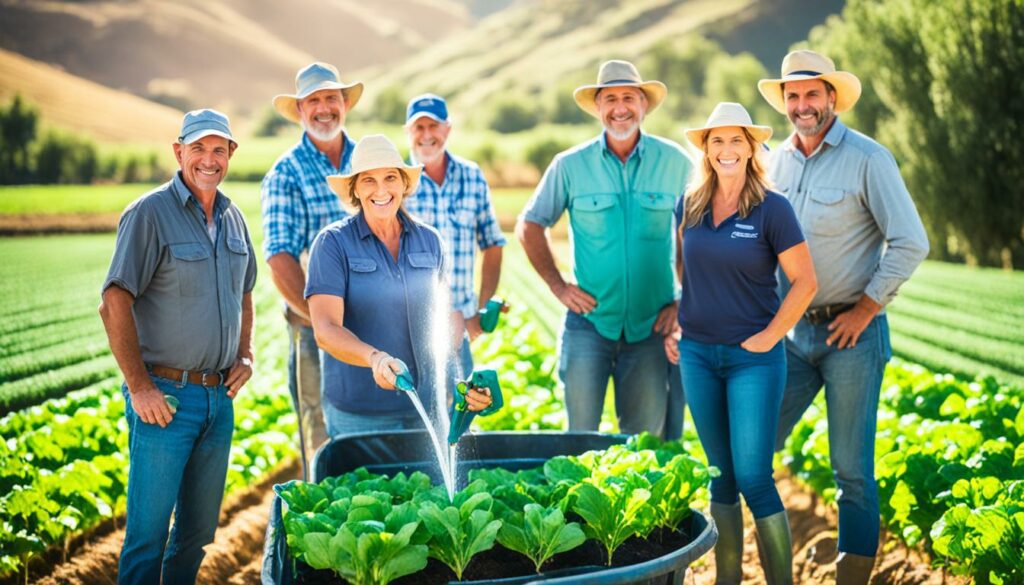
Also, companies making products and groups for the environment work together on green ways to make things. This team effort lowers water pollution and the use of resources. It makes our environment better and helps local causes and water projects. Energy firms also join in, working with nearby people to lessen the effect of their activities on water. This helps keep the whole community happier and healthier.
In California, the focus is on dealing with the problems from many small water diversions. Projects at the local water source aim to bring back the natural flow of streams. This work is key to help fish populations grow in California’s central and northern coast areas.
Plans for managing water are now community-based to help save water and bring back fish in important rivers. The California Environmental Water Network is a great example of how different groups and experts are coming together. They work better by sharing their skills and tools.
These efforts include making using water for farming better, keeping water from the wet season for the dry season, and helping out fish by sharing water when they need it most. Making it easier to get approval for these projects and getting agreements that protect those involved helps a lot more.
The ‘One Water for America Listening Sessions’ drew in over 500 leaders and keen support from more than 40 groups. This wide interest shows everyone is looking to join hands on managing water better. It also underlines how talking and working together is key.
With four in five water systems in the US small, serving under 3,330 people, and some even fewer these local water efforts are crucial. This includes about 51,000 water systems and 15,000 treatment plants. They create a complex network that needs shared care for keeping our water use smart and helping communities grow.
Collaborative water management in farming is vital for our future. With the world’s population expected to stabilise at 8,000 million, we need a smart approach. It must ensure we can meet our water needs. This includes improving how we use water in farming.
Two key parts are making our irrigation systems better and ensuring we grow enough food. This means governments and groups that provide money must choose wisely. They must support ways to manage water for farming. This is crucial for the future of food.
Integrated Water Resources Management (IWRM) is a very helpful plan. It helps to bring together different opinions and goals about water. We need to be careful not to use up too much water from the ground or rivers. This would harm the water supply in the long term.
So, we should all work together. We can do this by using different water sources carefully, looking at the weather when we plan, and making our farming water use more efficient. Steps like these can help look after water better for growing food.
Both countries and groups that give help must see the value of using water wisely in farming. Farming uses most of the world’s water. This means we can save a lot of water by farming smarter. By investing in new tools and changing the rules, we can make farming need less water.
Looking to the future, we must all come together. Farmers, local groups, water experts, and those who make decisions need to work as a team. Together, we can find ways to use water well in farming. This is vital for farming to thrive in the years to come.
So, our next steps in farming water use are clear. We must all be dedicated to new ideas, being careful with water, and working together. Let’s aim to turn these plans into real actions. This way, we can make a better future for farming.
Collaborative water management in agriculture involves the community, green methods, and high-tech solutions. It’s all about using water well and looking after our land. Farmers, local people, experts, and leaders all work together.
Getting the community involved is vital. It makes sure plans match local needs. This leads to smart, lasting solutions. It also builds trust and a long-term commitment to the rules.
Green farming methods save water. For instance, smart irrigation and careful crop choices make every drop count. This keeps farms healthy and saves our water supplies.
Integrated water management looks at the whole picture. It covers water, land, and more. The goal is to help farms thrive without hurting nature. This ensures everyone wins.
Technology is key to saving water on farms. It brings smart machines and clever data tools. With tech, farms can use just enough water. This helps crops grow and saves the planet’s water.
In the Sulphur Springs Valley, a big project showed how teamwork can save water. It involved people from farming and local authority. They worked together on clever plans to protect the area’s water.
Using smart tools and keeping an eye on the soil can cut water use. Such steps boost how farms use water. This is good for the environment and the business of farming.
Working together is key to managing water well. By joining forces, different groups can meet shared water goals. This makes for fair choices and a healthy water future.
These models get everyone involved in making water decisions. They aim for fairness and clear rules. This helps guarantee our water lasts for years to come.
There are challenges like getting everyone to agree. But, we also have chances to try new tech and better ways of working together. These can make our water use stronger.
Yes, many places have seen good results working together. They’ve grown better crops and made water safer for all. These are great examples of what teaming up can do.
We expect to see more digital tools and smart plans for climate change. These will help us use water even better and keep our farms strong.
Following water rules means our farming helps the planet. These rules guide us to use water wisely. They’re a big part of caring for our resources.
Working together on water means more jobs and a better life for all. It’s about using water in a way that grows our local places without harming the environment.